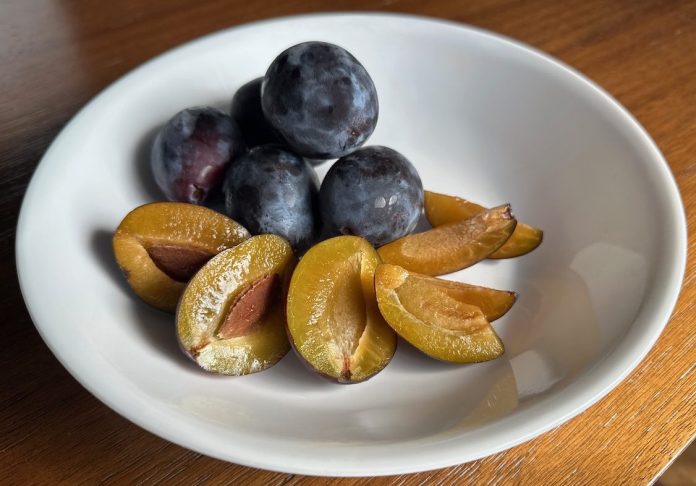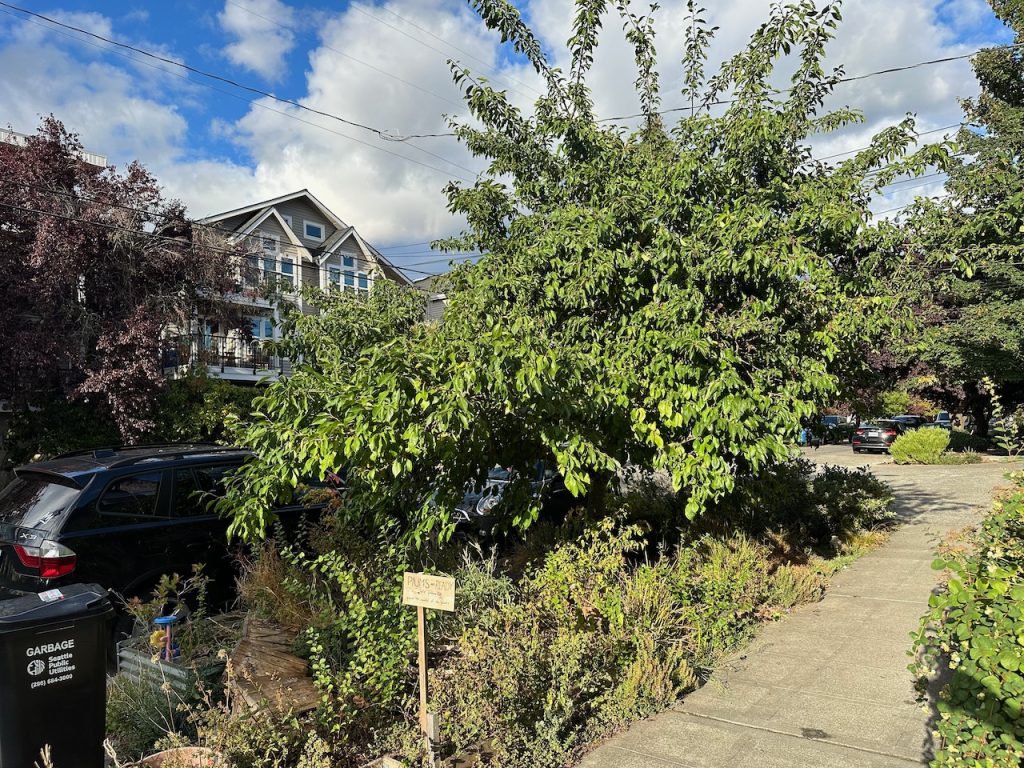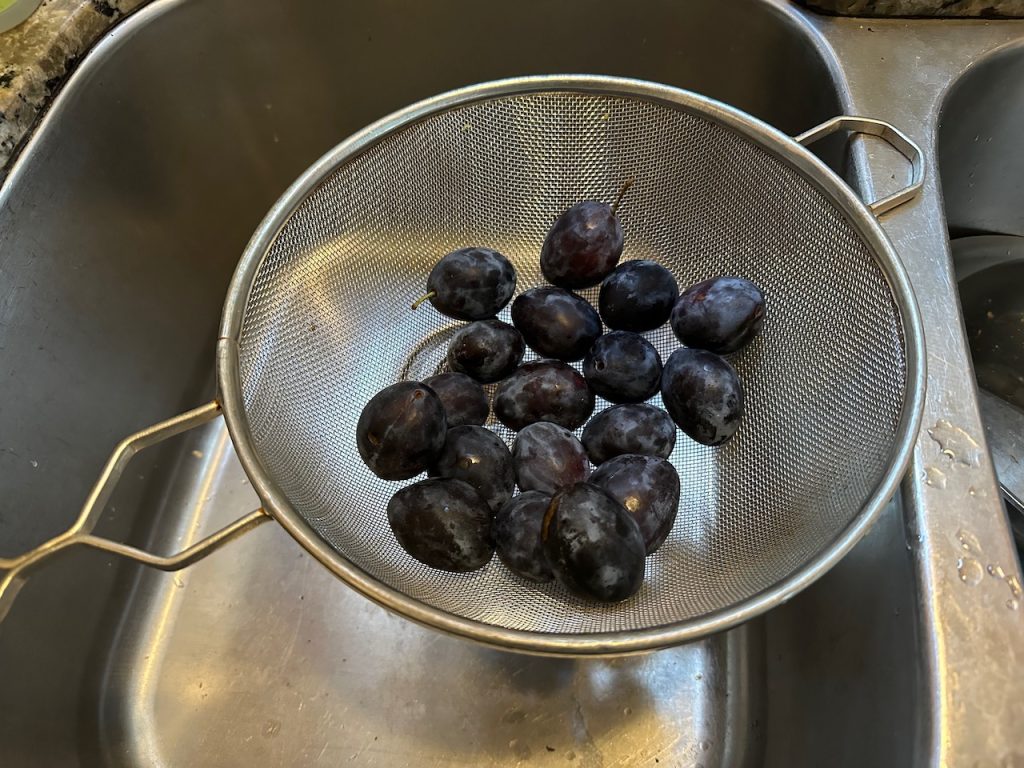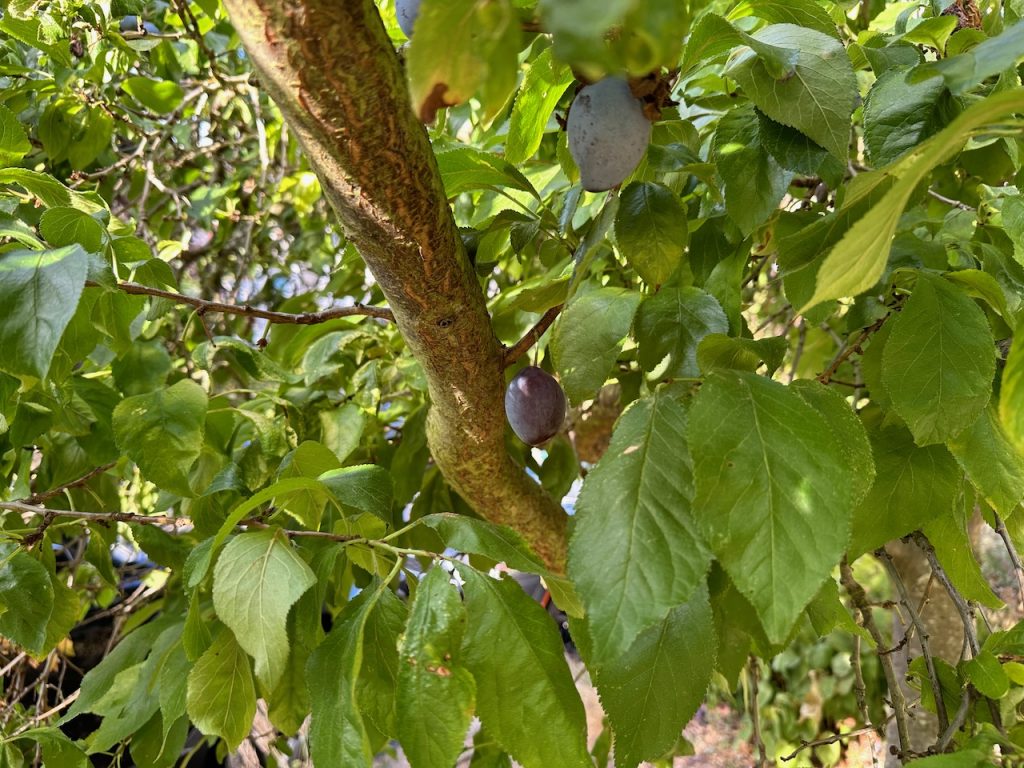
Small reminders to celebrate lots of good neighbors.
In the short gap of indecisive September clouds between Smoke Season and Spider Season, Seattle experiences one of the town’s most prized but understated traditions. It’s plum season. And it makes the city so much more livable.
Just after Labor Day, the fruit sharing begins. It’s been building quietly all summer. The tiny plum flowers of spring got overshadowed by their gaudy and presumptuous cherry blossom cousins. So the plum trees were left to their own devices, uncelebrated as the petals dropped and small berries formed. They were green for a lot longer than expected, not easy to pick out among the rest of the trees, and hanging underneath the canopy of leaves.
Then it happens. A drizzle or two breaks the rainless days that went on unexpectedly long. Sunset creeps before 9pm, then 8pm. All the white pants get put away for another year. Which is good, because some of the plums that just got dropped off on your porch stain like bad decisions at a Huskies game.

Northwest plums don’t tend to be the spherical red-purple billiard balls that manifest at the grocery store. The most commercially cultivated plum is a Japanese variety called the Friar. Grown all summer in Central California, or globally in the winter, grocery Friars are savagely hit or miss. Hits are sweet with bright red flesh inside a crisp, tart skin. Misses are rock hard and painfully sour.
Seattle’s plums are oblong, and tend towards blue-violet, almost dusty. They’re from European varietals, some super sweet and destined to be dried into prunes. The inside yellow flesh is virtually transparent against the ultra dark inside of the skin. Few will make it to get dried.
The prunes we receive from friends will sit on the counter and get picked over in drive-by fruitings. They’re freestone, so the flesh comes cleanly off the pit. It’s an easy routine. Bite. Chuck the stone. Second bite. Struggle not to grab three more.
Fairly tiny, it’s possible to get nine in a Ziplock sandwich bag, three dozen in a lunch bag. Which is nice and convenient for being dropped off in the mailbox by friends whose abundant tree production must leave their house. Technically the fruit doesn’t HAVE to go, but plums are famous for the gastrointestinal impacts of eating too many. On the level of another Seattle pastime: overdrinking coffee. And we avoid disagreeable digestive disasters just before autumn’s obligatory pumpkin spice lattes.
What’s interesting about Seattle’s plum-baree is how it flies under the radar. It doesn’t get international coverage like throwing ripe tomatoes. It doesn’t get national aghast like state fair concessions. It’s hard to say I even understood plum season as a *thing* years ago when we were at a friend’s house to kickoff the start of school. They said to grab a bag or two of plums on our way out. Then they did it again the next year. And the next year.
Nonchalant plum distribution was how it went until it didn’t. In September 2020, there was nothing, including a proper beginning of school. It’s only when our plum growing friends did a masked drop-off and remote greeting did Fete Du Plum become a notable, and more beloved, thing.
Other parts of the country see the produce hand-off between neighbors in different parts of the year. Berries in all forms show up much earlier, likely to show up in Easter pies. National Sneak Zucchini On To Your Neighbor’s Porch Day is in early August. What’s Thanksgiving other than an excuse to show off a bountiful harvest (to the folks you’re about to oppress). The Ingalls received wheat (by a little force) deep in The Long Winter.
It’s probably important that Seattle’s Plummining happens at the beginning of September. It’s the last wave of summer meets the dropping curtain of autumn. September is when people return from a ridiculous excursion or climb back out from under the assault of aircraft noise to remember that they have neighbors. Folks flip through their mental contact list to recall the families that they’d not had to remember since the last school drop off. Kids who spent summer playing in the yard get sectioned off for competing soccer teams. The realignments and the schedules and the rain is coming. Have some plums.
Inevitably, there’s going to be some goofball on r/Seattle who rubs two braincells together and produces the quip “Oh! The Urbanist hates trees and wants to bulldoze them for apartments. HoW yOu GoNna GeT yEr PluMs?!”
Conveniently, plum trees are prolific, unlike said Redditor’s unique thoughts. So you don’t need a ton of quality trees to supply a pretty good-sized community.
Also, since fruit trees are kept tightly trimmed, they’re really good street trees. They fit in wide sidewalk wells and under power lines. So we can have our dense apartments, and eat fresh fruit too! Of course, the fruit tends to be messy, were it to fall on a car. But, once they’re ripe, most plums don’t last long enough to fall.
True to The Urbanist style guide, I am obliged to say: Who really cares about cars. Cyclists can actually be powered by the plums. More bike lanes, please.
The best part about Seattle’s plum season is that the fruit’s amazing. The second best part is less about the fruit and more about the connections with folks who send them along. Cynically, that sounds like nonsense, the trope ending of “the real treasure being the friends we made along the way.” Friends don’t replace a competitive school system or functioning transit, and city policies that rely on vibes instead of good governance leave everyone poor and burned out.
Just like unpaid labor and endless public meetings, plums aren’t a salve for the city’s issues. They’re a treat. It is nice to get home to surprise fruit after waiting through the third full bus. It’s reminder that there are others around doing it too, they’re looking out for us, and autumn is pretty nice around here. And it’s okay to occasionally revel in the ways that people make Seattle a plum place to live.
A special shout out to the neighbor with a very plentiful plum tree in their street-side garden who puts a polite sign up saying “Please wait. They’re not ready.” And man, folks listened to that sign because the tree is bent with ripe fruit. This week, they switched the sign. I’ve seen folks come up with boxes, and kids just pluck them right as they’re walking by. It’s plum season in Seattle. Enjoy it before the spiders show up.
Ray Dubicki is a stay-at-home dad and parent-on-call for taking care of general school and neighborhood tasks around Ballard. This lets him see how urbanism works (or doesn’t) during the hours most people are locked in their office. He is an attorney and urbanist by training, with soup-to-nuts planning experience from code enforcement to university development to writing zoning ordinances. He enjoys using PowerPoint, but only because it’s no longer a weekly obligation.




